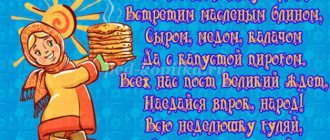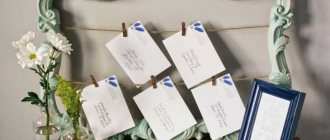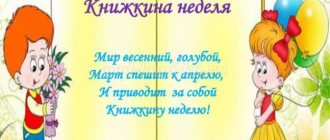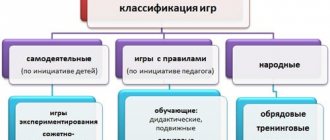Experiments for children of the preparatory group in kindergarten
Interesting experiments for children
In the preparatory group, conducting experiments should become the norm; they should be considered not as entertainment, but as a way to familiarize children with the world around them and the most effective way to develop thought processes.
Experiments allow you to combine all types of activities and all aspects of education, develop observation and inquisitiveness of the mind, develop the desire to understand the world, all cognitive abilities, the ability to invent, use non-standard solutions in difficult situations, and create a creative personality. Some important tips: 1. It is better to conduct experiments in the morning, when the child is full of strength and energy; 2. It is important for us not only to teach, but also to interest the child, to make him want to gain knowledge and do new experiments himself. 3. Explain to your child that you cannot taste unknown substances, no matter how beautiful and appetizing they look; 4. Don’t just show your child an interesting experience, but also explain in a language he understands why this happens; 5. Do not ignore your child’s questions - look for answers to them in books, reference books, and the Internet; 6. Where there is no danger, give the child more independence; 7. Invite your child to show his favorite experiments to his friends; 8. And most importantly: rejoice in your child’s successes, praise him and encourage his desire to learn. Only positive emotions can instill a love for new knowledge. Experience No. 1. "Vanishing Chalk"
For a spectacular experience, we will need a small piece of chalk. Dip chalk into a glass of vinegar and see what happens. The chalk in the glass will begin to hiss, bubble, decrease in size and soon disappear completely. Chalk is limestone; when it comes into contact with acetic acid, it turns into other substances, one of which is carbon dioxide, which is rapidly released in the form of bubbles. Experience No. 2. "Erupting Volcano"
Necessary equipment: Volcano: - Make a cone from plasticine (you can take plasticine that has already been used once) - Soda, 2 tbsp. spoons Lava: 1. Vinegar 1/3 cup 2. Red paint, a drop 3. A drop of liquid detergent to make the volcano foam better; Experience No. 3. "Lava - lamp"
Needed: Salt, water, a glass of vegetable oil, several food colors, a large transparent glass. Experience: Fill a glass 2/3 full with water, pour vegetable oil into the water. Oil will float on the surface. Add food coloring to water and oil. Then slowly add 1 teaspoon of salt. Explanation: Oil is lighter than water, so it floats on the surface, but salt is heavier than oil, so when you add salt to a glass, the oil and salt begin to sink to the bottom. As the salt breaks down, it releases oil particles and they rise to the surface. Food coloring will help make the experience more visual and spectacular. Experience No. 4. "Rain Clouds"
Children will be delighted with this simple fun that explains to them how rain falls (schematically, of course): first the water accumulates in the clouds and then spills onto the ground. This “experience” can be carried out in a natural history lesson, in a kindergarten, in an older group, and at home with children of all ages - it fascinates everyone, and the children ask to repeat it again and again. So, stock up on shaving foam. Fill the jar with water about 2/3 full. Squeeze the foam directly on top of the water until it looks like a cumulus cloud. Now use a pipette to drop colored water onto the foam (or better yet, trust your child to do this). And now all that remains is to watch how the colored water passes through the cloud and continues its journey to the bottom of the jar. Experience No. 5. "Red Head Chemistry"
Place finely chopped cabbage in a glass and pour boiling water over it for 5 minutes. Strain the cabbage infusion through a cloth. Pour cold water into the other three glasses. Add a little vinegar to one glass, a little soda to the other. Add the cabbage solution to a glass with vinegar - the water will turn red, add it to a glass of soda - the water will turn blue. Add the solution to a glass of clean water - the water will remain dark blue. Experience No. 6. "Blow up the balloon"
Pour water into a bottle and dissolve a teaspoon of baking soda in it. 2. In a separate glass, mix lemon juice with vinegar and pour into a bottle. 3. Quickly place the balloon on the neck of the bottle, securing it with electrical tape. The ball will inflate. Baking soda and lemon juice mixed with vinegar react to release carbon dioxide, which inflates the balloon. Experience No. 7. "Colored milk"
Needed: Whole milk, food coloring, liquid detergent, cotton swabs, plate. Experience: Pour milk into a plate, add a few drops of different food colors. Then you need to take a cotton swab, dip it in the detergent and touch the swab to the very center of the plate with milk. The milk will begin to move and the colors will begin to mix. Explanation: The detergent reacts with the fat molecules in the milk and causes them to move. This is why skim milk is not suitable for the experiment.
We recommend watching:
Experiments for children aged 2-3 years Experimental activities in kindergarten. Junior group Direct educational activities on experimentation in the middle group Integrated cognitive cycle lesson in the senior group on the topic: Winter
Similar articles:
Lesson notes on folk applied arts in the preschool group of preschool educational institutions
Card file of experiences and experiments in the preparatory group
The soil
Experiment “What is soil made of”
Show what soil is made of.
We put a little soil on a sheet of paper, examine it, determine the color, smell, rub the lumps of earth, find the remains of plants. Looking at it through a microscope.
B. Microbes live in the soil (they convert humus into mineral salts, which are so necessary for plants to live).
Experiment “Air in Soil”
Target. Show that there is air in the soil.
Equipment and materials. Soil samples (loose); cans of water (for each child); The teacher has a large jar of water.
Conducting the experiment. Remind that in the Underground Kingdom - the soil - there are many inhabitants (earthworms, moles, beetles, etc.). What do they breathe? Like all animals, by air. Suggest checking to see if there is air in the soil. Place a soil sample in a jar of water and ask to see if air bubbles appear in the water. Then each child repeats the experience independently and draws appropriate conclusions. Everyone finds out together who has more air bubbles in the water.
Experiment “Soil Pollution”
Target. Show how soil pollution occurs; discuss the possible consequences of this.
Equipment and materials. Two glass jars with soil samples and two transparent containers with water; in one there is clean water, in the other there is dirty water (a solution of washing powder or soap so that the foam is clearly visible).
Conducting the experiment. Invite the children to look at the water in both containers. What is the difference? Say that one contains clean rainwater; in the other there is dirty water left after washing. At home we pour this kind of water into the sink, but outside the city we simply throw it on the ground. Invite the children to express their hypotheses: what will happen to the earth if it is watered with clean water? What if it's dirty? Water the soil in one jar with clean water, and in the other with dirty water. What changed? In the first jar, the soil became wet, but remained clean: it can water a tree or a blade of grass. And in the second bank? The soil became not only wet, but also dirty: soap bubbles and streaks appeared. Place the jars nearby and offer to compare soil samples after watering. Ask the children the following questions.
If they were in the place of an earthworm or a mole, what kind of soil would they choose for their home?
How would they feel if they had to live in dirty land?
What would they think of people who polluted the soil? What would they be asked to do if they could speak?
Has anyone seen how dirty water gets into the soil?
Draw a conclusion: in life, as in fairy tales, there is “living water” (it falls into the ground along with rain, melted snow; it feeds plants and animals), but there is also “dead” water - dirty (when it gets into the soil , the underground inhabitants have a bad time: they can get sick and even die). Where does “dead” water come from? It flows down factory pipes and ends up in the ground after washing cars (show the corresponding illustrations or while walking, look for such places in your immediate surroundings, of course, not forgetting the safety rules). In many places on our planet, the earth-soil is polluted, “sick” and can no longer feed and water plants with clean water, and animals cannot live in such soil. What follows from this? We need to take care of the Underworld and try to make sure it is always clean. In conclusion, discuss what children (each of them), their parents, and teachers can do for this. Tell us that in some countries they have learned to “treat” the soil - to clean it of dirt.
“We are for a healthy lifestyle (experiences, experiments on the topic: “Health”)
author: Tikhomirova Nadezhda Vyacheslavovna
physical education instructor Municipal autonomous preschool educational institution “Kindergarten No. 4 “Rainbow”, Nebolchi village, Lyubytinsky district
“We are for a healthy lifestyle (experiences, experiments on the topic: “Health”)
Municipal autonomous preschool educational institution “Kindergarten No. 4 “Rainbow”, Nebolchi village
Lyubytinsky district, Novgorod region.
Competitive work of an educational lesson on the topic:
"Healthy lifestyle
(practical experiences and experiments)"
Purpose of the event:
with the help of experiments and experiments, show the children the need for body parts and a healthy lifestyle.
Participants:
children 5-6 years old.
The event takes place in a spacious room. The necessary items for experiments and experiments are prepared on the table in front of the children.
Light music is playing.
Progress of the event:
-Hello guys. Today I invite you to a magical room where you will see a lot of interesting and useful things. You will be my assistants, little wizards. Are you ready to see and complete difficult challenges?
First challenge "Find the person"
Target:
introduce the structure of the human body: torso, legs, arms, neck, head.
Equipment:
a set of toys (a naked doll, a fish, any animal, a bird), a “wonderful bag”.
Carrying out:
Invite the children to play the game “wonderful bag”: find a person (doll) in the bag by touch. Children take turns completing the task and explaining how each of them found out that this was a man, and why they didn’t choose another toy (it has a tail, wings, etc.)
Second Test "Significance of Hands"
Target:
Experimentally show children the importance of hands for human life.
Equipment:
candies, clothing items.
Carrying out:
- how can you eat candy without hands - hands behind your back, candy on the table. Try to eat candy (call 2 children).
- call two children, one child puts on an item (pants, sweater, sandals, etc.) with both hands, and the other with one hand. The results are compared.
Conclusion: hands are important in our lives. Therefore, you need to treat them with care and train their strength.
Third test “How germs are transmitted from person to person”
Target:
show children experimentally how germs are transmitted from person to person
Equipment:
body gel with glitter (eyeshadow)
Carrying out:
Before the experiment, an adult applies body gel (shadow) with glitter to his palms. Then he invites the children to shake hands, while tightly squeezing each child’s palm. After this, the adult “unexpectedly” discovers that his palm is dirty and asks the children to look at their palms. Children see traces of glitter on them. A conclusion is drawn about how invisible microbes are also transmitted through contact with another person (or with an object, with an animal).
Fourth test "The meaning of the elbow joint"
Target:
show empirically the importance of the elbow joint
Equipment:
two thin boards 30-35cm long, 5-7cm wide, elastic bandage or Velcro tape - for fixing the elbow joint
Carrying out:
Two children are called in, one of them has his elbow joint fixed. Children are given a task - to bring a spoon to their mouth, scratch an ear or stroke their tummy, put on a hat, fasten a button on a shirt, etc.
Then the conclusion is drawn: it is impossible to complete these tasks if the arm does not bend.
Fifth test “I’ll name it, and you show it”
Target:
show experimentally the importance of eyes for human life.
Equipment:
two identical sets of items, a scarf
Carrying out:
The experiment is carried out in pairs, one of the children is blindfolded. Two identical sets of objects are placed on two tables (for example, red and blue cubes, pyramids, toy cups and plates, colored pencils, etc.); upon instructions from an adult, children must show a certain object. The correctness of the task is checked. Conclusion - when the eyes are blindfolded, the task cannot be completed.
Note:
If the child chose the object correctly, the question is asked: how were you able to complete the task, because you did not see the toy? (by touch, with your hands)
Sixth test “I hear - I don’t hear”
Target:
Experimentally show children the role of the ear in capturing and distinguishing different sounds.
Equipment:
cotton wool
Carrying out:
An adult stands behind the child at a distance of 2–3 m, pronounces various words, and each subsequent word must be pronounced in a quieter voice. First, cover one of your child's ears with a cotton swab. Repeat the experiment. Then cover both of the child’s ears with a cotton swab. Repeat the experiment. After this, ask the child to talk about his feelings, so that he explains when it was heard well, when it was worse, when nothing was heard at all and why.
Seventh test " Smart Nose"
Target:
identify objects by smell, get acquainted with the peculiarities of the nose.
Equipment:
a scarf, foods with a characteristic smell (fresh bread, fresh cucumber, orange, garlic, onion, etc.), a flower, a perfume bottle, “kindersurprise containers,” pictures of objects
Carrying out:
An adult calls several children to him in turn, blindfolds them and asks them to identify by smell what he is bringing to them. The child explains how he determined what is in front of him. Then, you need to determine what is in the “kindersurprise” and find the corresponding picture.
Eighth test “The importance of the nose for speech”
Target:
Experimentally show children the importance of the nose for speech.
Equipment:
–
Carrying out:
The adult asks the child to close his nose and say a word. The conclusion is drawn: the sounds change and become unclear. Then the child with his nose closed reads some poem, discussion with the children.
Ninth test “Helper tongue”
Target:
introduce the meaning of language, practice determining the taste of foods.
Equipment:
scarf, set of food products (pieces of fruits and vegetables, bread, chocolate, etc.), plates, skewers (toothpicks)
Carrying out:
An adult calls several children, blindfolds them, and offers to identify different foods according to taste. To do this, you need to prepare small pieces of food; the adult asks the child to try a piece and answer the questions:
- What it is?
– What does this food taste like? (bitter, sweet, sour or salty)
– How did you determine the taste of food, who helped you?
“We are for a healthy lifestyle (experiences, experiments on the topic: “Health”)



